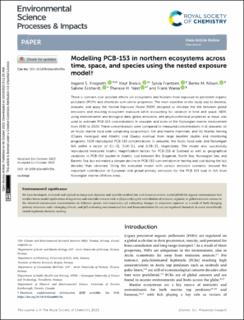| dc.contributor.author | Krogseth, Ingjerd Sunde | |
| dc.contributor.author | Breivik, Knut | |
| dc.contributor.author | Frantzen, Sylvia | |
| dc.contributor.author | Nilsen, Bente Merete | |
| dc.contributor.author | Eckhardt, Sabine | |
| dc.contributor.author | Nøst, Therese Haugdahl | |
| dc.contributor.author | Wania, Frank | |
| dc.date.accessioned | 2023-10-16T13:28:48Z | |
| dc.date.available | 2023-10-16T13:28:48Z | |
| dc.date.created | 2023-10-10T10:05:15Z | |
| dc.date.issued | 2023 | |
| dc.identifier.citation | Environmental Science: Processes & Impacts. 2023 | en_US |
| dc.identifier.issn | 2050-7887 | |
| dc.identifier.uri | https://hdl.handle.net/11250/3096778 | |
| dc.description.abstract | There is concern over possible effects on ecosystems and humans from exposure to persistent organic pollutants (POPs) and chemicals with similar properties. The main objective of this study was to develop, evaluate, and apply the Nested Exposure Model (NEM) designed to simulate the link between global emissions and resulting ecosystem exposure while accounting for variation in time and space. NEM, using environmental and biological data, global emissions, and physicochemical properties as input, was used to estimate PCB-153 concentrations in seawater and biota of the Norwegian marine environment from 1930 to 2020. These concentrations were compared to measured concentrations in (i) seawater, (ii) an Arctic marine food web comprising zooplankton, fish and marine mammals, and (iii) Atlantic herring (Clupea harengus) and Atlantic cod (Gadus morhua) from large baseline studies and monitoring programs. NEM reproduced PCB-153 concentrations in seawater, the Arctic food web, and Norwegian fish within a factor of 0.1–31, 0.14–3.1, and 0.09–21, respectively. The model also successfully reproduced measured trophic magnification factors for PCB-153 at Svalbard as well as geographical variations in PCB-153 burden in Atlantic cod between the Skagerrak, North Sea, Norwegian Sea, and Barents Sea, but estimated a steeper decline in PCB-153 concentration in herring and cod during the last decades than observed. Using the evaluated model with various emission scenarios showed the important contribution of European and global primary emissions for the PCB-153 load in fish from Norwegian marine offshore areas. | en_US |
| dc.language.iso | eng | en_US |
| dc.rights | Navngivelse 4.0 Internasjonal | * |
| dc.rights.uri | http://creativecommons.org/licenses/by/4.0/deed.no | * |
| dc.title | Modelling PCB-153 in northern ecosystems across time, space, and species using the nested exposure model | en_US |
| dc.title.alternative | Modelling PCB-153 in northern ecosystems across time, space, and species using the nested exposure model | en_US |
| dc.type | Peer reviewed | en_US |
| dc.type | Journal article | en_US |
| dc.description.version | publishedVersion | en_US |
| dc.source.journal | Environmental Science: Processes & Impacts | en_US |
| dc.identifier.doi | 10.1039/D2EM00439A | |
| dc.identifier.cristin | 2183186 | |
| dc.relation.project | Norges forskningsråd: 244298 | en_US |
| dc.relation.project | Norges forskningsråd: 267574 | en_US |
| dc.relation.project | Norges forskningsråd: 287114 | en_US |
| dc.relation.project | Norges forskningsråd: 311503 | en_US |
| dc.relation.project | Framsenteret: 132018 | en_US |
| dc.relation.project | Framsenteret: 142018 | en_US |
| dc.relation.project | Framsenteret: 522018 | en_US |
| dc.relation.project | NILU: 118058 | en_US |
| dc.relation.project | NILU: 119008 | en_US |
| dc.relation.project | NILU: 117044 | en_US |
| dc.relation.project | NILU: 117056 | en_US |
| dc.relation.project | NILU: 118037 | en_US |
| cristin.ispublished | true | |
| cristin.fulltext | original | |
| cristin.qualitycode | 1 | |

